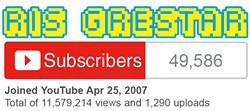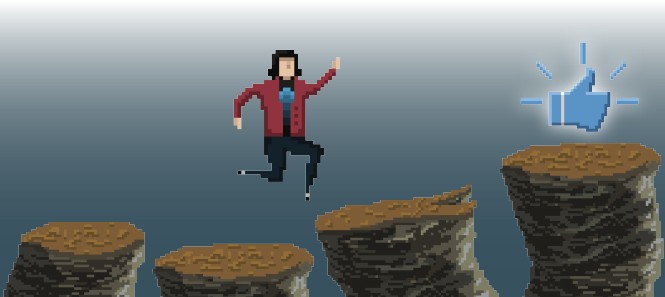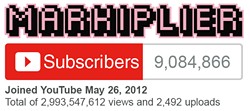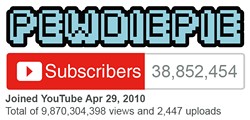Let's Play!
Gamers scream, swear and fight their way to newfound celebrity on YouTube
By Gavin Sheehan @TheGavinSheehanEarly in the afternoon, after waking up, showering and grabbing a bite to eat, Dean Richards powers up a computer and turns on some lighting equipment. He sits down in his dining-room-turned-makeshift-studio and pans through his vast inventory of games. He turns on a camera, fires up recording software, kicks the Steam client into action and dons his customary hat. After the game loads to the start screen, Richards hits the "record" button and immediately comes alive as the pleasantly happy and easygoing YouTube personality Ris Grestar. All this takes place in Cottonwood Heights on a typical neighborhood street, in an average split-level home with a tidy facade and maybe one dog barking in the distance. It's not the type of place you'd expect to find a local YouTube celebrity. But the fact is: An online media star currently resides in our valley, and he's gaining more fans even as you read this article.
This 22-year-old gamer is a Let's Player, with more than 48,000 subscribers. Simply put, he makes his living playing video games while people watch online. Each month, YouTube sends him a check for showing up to work. If that gig sounds too good to be true, it may surprise you to learn Let's Play is actually a growing entertainment genre across the globe, with the majority of content creators coming from North America and Europe, and it has become the latest viewing pastime for the coveted 18-to-36-year-old demographic that marketers long to reach.
Let's Play 101
The uninitiated may be asking: What the hell is a Let's Player? For starters, Let's Players (along with a coterie of video bloggers, product reviewers, musicians, comics, rappers, artists and more) live on YouTube, the video-sharing website that is the second-largest search engine in the world (next to Google, which owns it). YouTube's channels have long been a refuge for video gamers eager to connect and share experiences with other gamers.
Within YouTube's first year (it's only been around since 2005), gamers who created profiles figured out that they could utilize video channels to show off digital clips they recorded from games they played. This trend created a fan base and allowed gamers to tout their achievements with popular games like Halo, World of Warcraft and Call of Duty. The bragging rights spawned into what is commonly known as "the walkthrough."
When playing video games on YouTube, a gamer will play a new video game such as The Witcher 3 from the beginning. That gamer will walk through or play that title all the way until the end, including cut-scenes and visual aids, eventually completing the game and earning the online cred that comes from having done so.
Game developers and hardcore gamers have had issues with this over the years, claiming that watching a walkthrough ruined the experience for gamers who were stuck and wanted to finish the game. It encouraged those who needed a cheat guide (which helps players experience the story without having to needlessly struggle with a certain part of the game) but it potentially robs publishers of profits they might have earned if that person purchased the game instead of watching it being played.
On the other hand, gamers who create YouTube videos argue it helps promote the game to those on the fence about buying it. Plus, it provides entertainment to an audience that isn't likely to plunk down the $60 for a game they weren't going to play anyway.
Gamers began adding commentary to their recordings in the late '00s, using headsets they purchased with their console or computers to chat with people through multiplayer games. As the trend grew, personalities emerged to the point that those creating the videos developed personal connections with their audiences, and that resulted in hordes of subscribers and views. According to the video-game blog Kotaku, Michael "Slowbeef" Sawyer first coined the term "Let's Play" for this particular format roughly five years ago, and shortly thereafter, users like PewDiePie, Markiplier, Cinnamon Toast Ken, Dodger, TheRPGMinx, Cryaotic, Achievement Hunter, Jessie Cox, ProJarod and more began making names for themselves using the new format, transforming it in a few short years into the veritable profession it is today.
YouTube is beginning to come to grips with Let's Play's use of copyrighted materials. The company is surprisingly supportive of Let's Players while recognizing the need for system management. "We work to be a home for the entire gaming community—publishers, gamers, viewers and everything in between," says YouTube's communications manager Matt McLernon in an email. "That's why we've built the best video-sharing, engagement and copyright management tools so that we're allowing people to connect around the games they love, while enabling copyright owners to manage how their content is used on YouTube."
Utah Talent
Gaming had always just been a part of Dean Richards' life growing up. Even as a child, he remembered seeing his dad play Sonic the Hedgehog in the garage. As a younger teen, he would race his brother Dartanian home to play Pokémon Yellow. The Richards brothers were raised in a Nintendo home, venturing outside the brand only to include the dragon platformer Spyro and first-person shooter Halo. When his brother moved away to attend college, he took all the console games with him, forcing Dean to find new gaming experiences in the PC world. This opened up more gaming possibilities and a greater library, not to mention more reliable experiences than his Wii allowed, as it kept breaking down
He began watching Let's Players during his first year of college in 2011. He had moved in with a friend who was gone most of the time for work, so he'd entertain himself by watching YouTube. That's when he stumbled upon the account of Toby Turner, aka Tobuscus. Then, he began watching two other players—Swedish-based comedic gamer PewDiePie and Ohio-based horror-gamer Markiplier—who served as inspiration and motivation for him to go out on his own.
"I showed my little brothers [a video of] Toby playing Slender: The Eight Pages when I went to visit one time. And then they wanted to watch me play it," Richards said. "But I know that I'm a chicken, and I didn't want them to watch over my shoulder.
"So I said, 'All right, I'll record it for you, and then you can watch that.' I felt more comfortable that way. So, I recorded it, and that was kinda fun because I got to rewatch that and relive that—but from an audience kind of perspective of myself. It was amusing."
He moved on to other games with his brothers as his only audience, but around the time they started losing interest, others had caught on and noticed his YouTube channel. As comments and subscribers started trickling in, Richards made the decision to start making videos on a regular basis. It was a way of giving back to the community: As someone who had been entertained over the years with YouTube content, it became a heady experience to contribute to the ever-growing free media giant.
As his audience continued to grow, he felt an obligation to not let them down, so he put up new content on a daily basis. He took on the moniker of Ris Grestar, a combination of a nickname he created years ago playing the sci-fi role-playing game Star Wars: Knights of the Old Republic, and a handle he made on a Star Fox forum, based around the popular Nintendo space-shooter game.
Over time, he had the means to purchase and incorporate new recording technology, carefully choosing the right camera, microphone and software needed to make his videos look like those of the pros who had come before him. He studied to make sure the background wasn't cluttered and that the lighting was well set—not to mention that the computer had sufficient resources that it didn't lag. He finally snagged a Blue Yeti microphone and went through two cameras before finding one to do 1080p high definition, the Logitech C920 camera. He continued to grow his audience of subscribers and viewers as he screamed and fought his way through games like the action role-playing Oblivion, the fantasy god game Spore, the rampaging damage animal game Goat Simulator and the current king of intense horror games, Five Nights at Freddy's.
"As [the audience] was building, it was really awesome," says Richards, reflecting on his subscribers. "Just having that returning audience and seeing people who were like, 'I had all these issues at school and everything. Then I came home and watched your video, and now it's all better.' Hearing things like that is always great."
That fan base allowed Richards to take gaming from a hobby to a job. The paycheck comes through YouTube's setup that allows content creators to place ads on their videos. Richards earns a small amount of money every time an ad is seen. (On a side note, YouTube does not count views from viewers utilizing ad/pop-up blockers, and he earns no credit on those views.)
As Richard's audience grew, the monetization of his videos increased to the point where he started receiving checks from YouTube. The money he earns is based on the view-count for each video (roughly 1/10 of a penny per click), as well as the ads he allows YouTube to play at the start and that run along the bottom of his videos. That may not seem like a lot, but once you start posting videos daily with thousands of hits per day—those pennies add up. As of press time, Richards was nearing 50,000 followers (which is more subscribers than all Utah media YouTube channels combined), with YouTube sending him a check for roughly $600 per month.
"Anyone can choose to advertise on their videos, and the creator earns the majority share of that revenue," notes YouTube's McLernon. "What a creator can earn is dependent on three things: The type of advertisements purchased (video, display, etc.), the creator (how big their channel is/number of subscribers) and the viewer (what country they're watching from, demographic, etc.)."
Invited to the White House
While Richards' earnings might seem modest for a lot of work (or play), he's got every reason to be optimistic about his prospects. Consider Mark Fischbach, aka Markiplier. Raised in Ohio, Fischbach grew up an obsessed gamer, with titles like the sci-fi piloting games of the Star Wars: X-Wing series, fantasy shooter game Magic Carpet 2, first-person shooter DOOM and the earth-creating strategy game Populous 3 among his favorites.
Fischbach experienced a lot of ups-and-downs in his personal life throughout his teenage and young-adult years, but gaming always remained a source of fun for him. While in college studying to become a biomedical engineer, his brother introduced him to the concept of Let's Play videos, which were just getting their start.
In 2012, shortly after losing his job and girlfriend and while dealing with a swollen appendix, the then-23-year-old Fischbach made the decision to take control of his life and do things he wanted to do. He started with the idea of doing sketch-comedy videos for YouTube, but that morphed into him creating his own identity, which became Markiplier. The hits didn't come in right away, but his few fans made the venture worth the time.
In the beginning, Fischbach said, it was "busy. I was so enamored with the process of making videos and responding to people's comments and emails that nothing else mattered. I always love the feeling of being completely obsessed with a new venture and this was as far down the rabbit hole as I'd ever been. I would delay going to bed and sacrifice sleep just so I could get back to making more videos and seeing what people thought of yesterday's ones."
Video series on games like Amnesia, Cry of Fear and "Drunk Minecraft" (where he and fellow gamers Bob & Wade take shots while playing) garnered the biggest hits, and in a matter of months, Markiplier's channel grew from 400 to 10,000. His personality as an excited gamer willing to try anything shone through, even if it terrified him and threatened to give him a heart attack before he turned 30. Within a year, he had racked up 1 million subscribers.
Suddenly, without warning, he faced a catastrophic moment for any content creator: YouTube shut down his original channel, and he learned a big lesson at the height of his first run.
"YouTube's early systems were all automated," Fischbach recalled. "Therefore, there were a lot of false-positives about people trying to exploit the monetization system. I was just one of those unfortunate cases that had their monetization disabled and no one to appeal to. I realized almost immediately that I had to move on, but it was so heart-breaking to lose what I thought was mine."
When asked to comment on the closure of Fischbach's first channel, YouTube representatives declined to comment.
After a conversation with fellow gamer, Wade, over what to do, Fischbach relaunched his channel under a new name and reloaded all his videos, this time complying strictly with the YouTube system. The audience he once had returned in droves and re-clicked all his videos in support of his work and the community he created. He threw himself into the endeavor, and it paid off big time. His fanbase doubled, and his videos received more exposure than those of most of his peers. Shortly after, in 2014, he moved to Los Angeles to work with Maker Studios and join the growing community of Let's Players in developing content.
Rather than resting on his laurels as an Internet celebrity, Fischbach uses his stardom to benefit charities, such as Best Friends Animal Society Los Angeles and the Cincinnati Children's Hospital. He's been invited to attend conventions across the United States to meet fans, has taken part in award shows and presentations such as NewFront, and he even was invited to the White House to talk about the impact gaming has on the upcoming generation.
The medium has given Fischbach a chance to communicate personally to his audience about topics such as depression and suicide. Being a voice of hope and inspiration to those who may be in a dark place is another way he likes to give back to his fans.
As of press time, Markiplier's YouTube Let's Play channel just surpassed the 9 million subscriber mark (second only to PewDiePie, aka Felix Kjellber, with over 38 million), putting him in YouTube's top 50 channels in 2015. In a five-year period, he grew from an unknown gamer to one of the most influential people in new media by simply being himself and doing something he enjoyed.
Fischbach wouldn't say how much he earns from YouTube, but a 2014 Wall Street Journal article noted that Let's Player PewDiePie raked in $4 million in ad sales annually. It's enough to motivate gamers like Richards to get into the game.
Legal & Ethical Quandaries
As with many genres of media that utilize other creator's content to create new content, Let's Play's sampling of video-game content resides in a legally gray area. Game developers argue they own the copyrights and, therefore, deserve profits made from their creations, while others argue that adding commentary and not showing the full gaming experience is allowed under the claim of fair use. In a March 2015 Wired interview with Let's Player MasaeAnela, writer Chris Kohler noted that, while developers are entitled to claim advertising revenue from a gamer's video that uses any video-game footage (or have it removed from YouTube), "they could be stepping over dollars to pick up pennies."
Nintendo, in particular, takes a hard line. It openly challenged gamers through YouTube's Content ID program (an automated filter that alerts copyright holders of unallowed use of their intellectual property), only to backtrack and start a Let's Play program of its own. Now, players can basically work for Nintendo on its approved list of games to create videos, and the company will share part of the profits earned from YouTube for using Nintendo content. However, if its done without consent, Nintendo can have videos taken down and/or pursue copyright-infringement in court.
Many Let's Players called foul on Nintendo's program, and subsequently stopped playing newer Nintendo titles, effectively taking them out of the current rise of content. PewDiePie openly spoke out against Nintendo's program on his blog, and in April 2015, Polygon documented Let's Player "Angry Joe" Vargas' response to Nintendo pulling his content.
Copyright issues are one concern; ethical disclosure is another. Many gamers openly admit receiving free games and promotional items. In a March 2015 video, PewDiePie filmed his own adventure as he took a tour of Square Enix in Japan before a Final Fantasy app was released later that spring. PR firms now have established systems where Let's Players can request free copies of games for their channels, but rarely do players disclose that games were free, raising concerns over the credibility of their reviews. It begs the question: Once a product has been given to a player free of charge from a game developer that will be making more games down the line, with no established code of ethics, how can fans trust the opinions of players?
When asked about this, Mark Fischbach (aka Markiplier) said, "it really doesn't faze me at all—mostly because I often forget that I am in a considerable position of influence that companies would find valuable. I try not to focus on those sorts of things, because it distracts from what I'm really here to do: make people laugh. Most of the time, if I'm recording a game that I don't like, I'm not going to upload it, plain and simple. When I'm giving my thoughts on the games that I play, I try to stay as open and honest as possible at all times."
City Weekly attempted to discuss these concerns with several game developers, ranging from local companies such as Ninja Bee to international brands like Nintendo, and even public relations companies such as One PR and Evolve who deal directly with developers and players from various forms of media. However, they either did not respond or declined to comment on this story.
Let's Play: Is It Worth It?
It's easy to compare the rise of Let's Play videos with that of podcasting. Other media disrupters include Vine's six-second videos and BuzzFeed's lists. Each new form of entertainment and news delivery started in the same way: A brave few latched onto an idea and made it popular, and within a few years, fans started trying it out for themselves. Fans can now aspire to their own 15 minutes of fame. While there are no official stats as to how many people try Let's Play every week, a YouTube search for "Let's Play" retrieves tens of thousands of hits uploaded within the past week—and more than 1.5 million overall. That should give some idea to its popularity.
When Markiplier was asked if the onslaught of new players diminished the work he and others have accomplished, he brushes it off completely: "Oh, pish posh! Good and bad are so subjective. It's pointless to even try to differentiate the two across the spectrum of people watching on YouTube," he said. "There's no point in trying to protect our sand castles just because the beach got crowded. If my channel were to collapse tomorrow under the weight of a thousand shitty channels, it wouldn't stop me from being me. I'd just move on to something else that I enjoy."
YouTube has chosen to embrace the phenomenon, both by encouraging new content and being more in-touch with members who have high-profile accounts. "YouTube has the most vibrant, diverse and engaged gaming community built by hundreds of millions of gamers during the past 10 years," writes YouTube McLernon in an email. "Each member of this community has been at the tip of the spear when it comes to creating new collaborative and interactive formats that have fundamentally reshaped the video game landscape, and pushed YouTube forward."
McLernon noted that YouTube provides gamers with a wide variety of resources, ranging from YouTube.com/creators to its YouTube Spaces.
Meanwhile, back in Utah, Richards joins the second wave of Let's Players expanding the field with diverse commentary. He's optimistic about his future in a genre where new talent shows up daily, with new games to play and new viewers to share videos with hourly.
"In the next few years, I'm hoping to reach 100,000—because it is such a big milestone," Richards says. "And I'm hoping it will be a lot faster than that. I like to aim low, so I'm not disappointed, but pleasantly surprised. But I'm hoping it will continue like it has been. Right now it's about 50-100 [new subscribers] a day, which is still great, I'm still very happy about that. I try to have a friendly community, so the people really love me and watch my videos; I feel that they're the same way. They're there to have a good time—we try not to argue a lot or put other people down.
"I love seeing all those good comments like 'keep up the good work' and see people interacting in the comments and having a good time. That's really exciting."
More by Gavin Sheehan
-
Gavin's Underground: End Of An Era
Nine and a half years of local entertainment blogging comes to an end.
- May 26, 2017
-
Torris Fairley
A quick interview with the up-and-coming SLC-based comedian.
- May 25, 2017
-
Cirque Asylum
A look into the dance school teaching unique forms of aerial arts.
- May 24, 2017
- More »
Latest in Cover Story
Readers also liked…
-
Forget the family pedigree—Robert F. Kennedy Jr should not be the next president of the United States
Trojan Horse
- Jun 21, 2023
-
Women decry harassment and toxic culture at St. George auto dealership
Men at Work
- Oct 11, 2023














